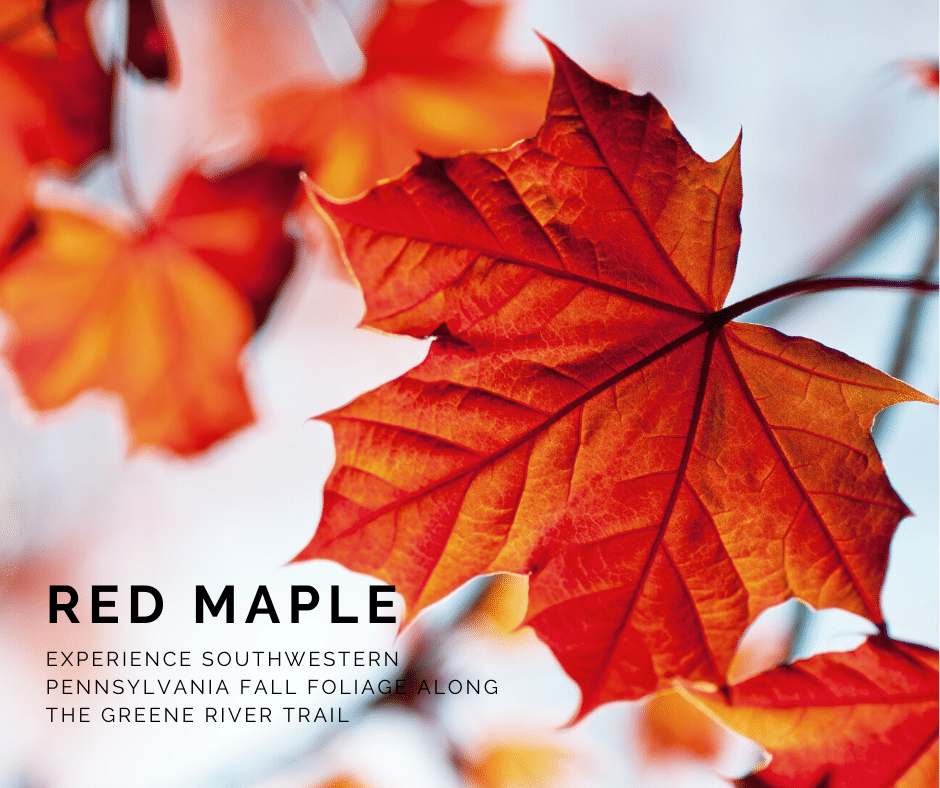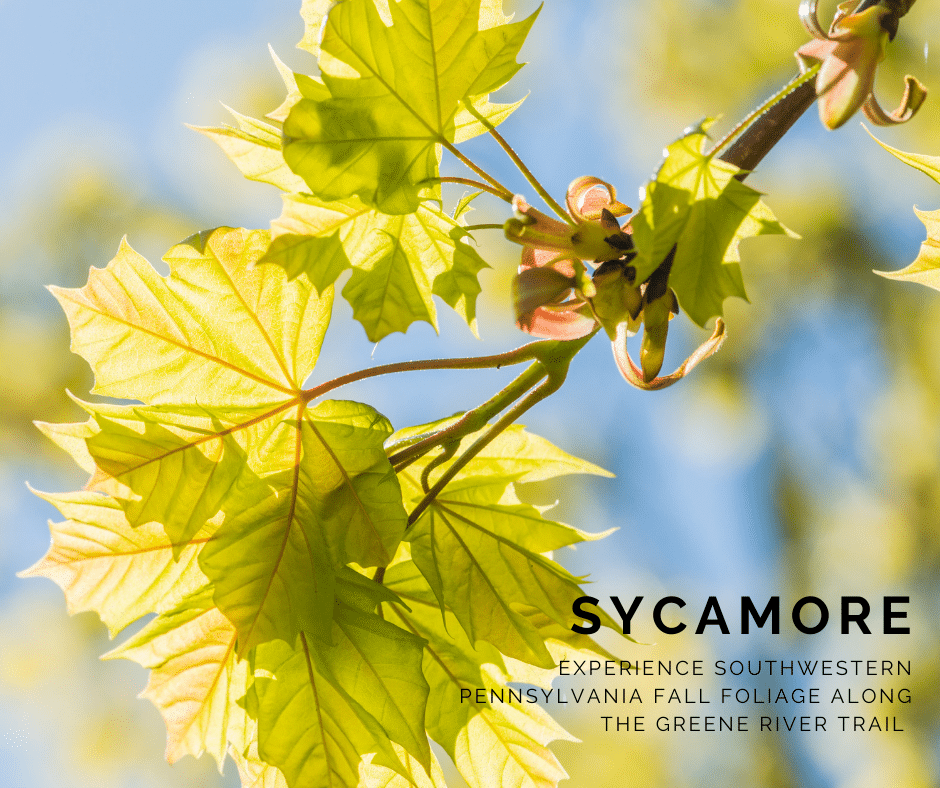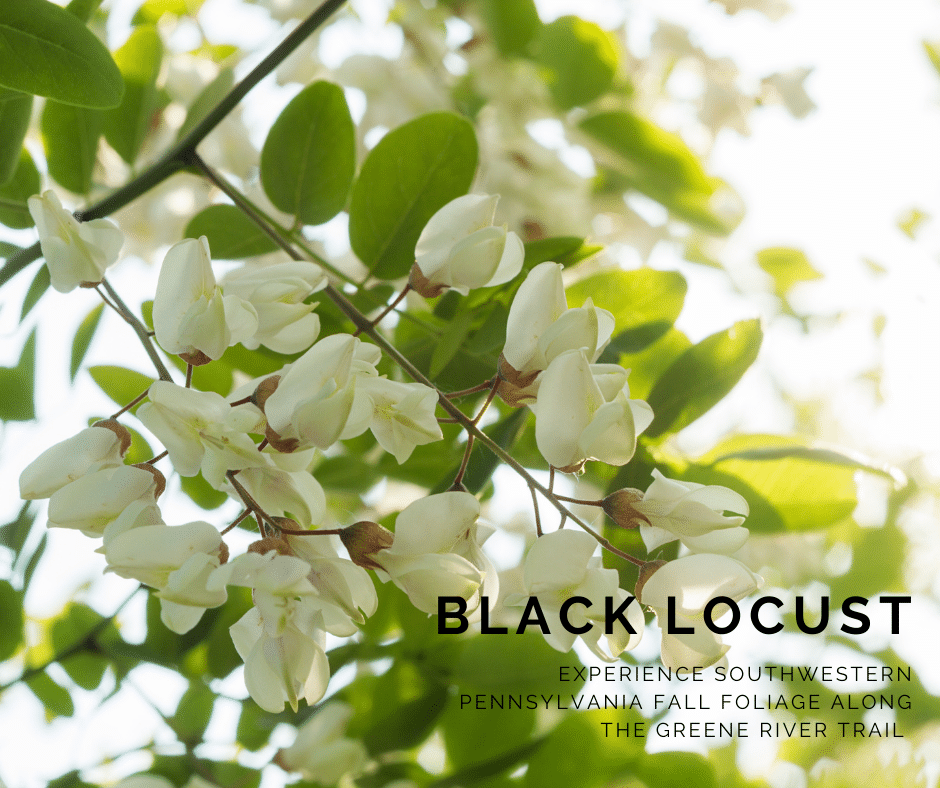Experience Fall Foliage Along the Greene River Trail
From green to gold, orange, red, and brown, fall hues saturate Pennsylvania forests and outline the sky during the month of October. While peak foliage typically occurs during the third week of the month, the entire autumn season offers a spectrum of color as leaves fade from green and reach their most brilliant autumnal shades. For a journey through a cascade of warm reds, oranges, and golds, visit the Greene River Trail in Greene County this fall. Along the way, you can expect to see a variety of trees and learn how to identify them.
Red Maple (Acer rubrum)
The red maple is the most abundant tree in Pennsylvania growing in a wide variety of habitats, typically reaching 80 feet to 100 feet high. It grows best in wet soils and is known as the soft maple because its wood is not as hard as sugar maple. This is an excellent ornamental tree, as they will be adorned with leaves of bright red or orange come mid-October. Young trees are heavily browsed by deer and rabbits, and rodents consume their seeds.

Silver Maple (Acer saccharinum)
The silver maple is found in moist woods and on stream banks throughout Pennsylvania, the largest reaching 100 feet high. The Silver Maple can be identified by the silvery-white undertones of its leaves. The bright green tops of the leaves will transform into a more golden tone come autumn. Many mammals and birds eat the seeds. It is planted as a shade tree, but has a tendency to split.
Redbud (Cercis canadensis)
The Redbud is usually a small tree, with a short trunk and branches forming a shallow broad crown. Typically, they range from 15 feet to 20 feet high with a trunk diameter of six inches, but have been known to reach 30 feet high in Pennsylvania. This tree is prized for its bright rose-colored flowers in early spring. The blossoms are replaced by bright green leaves in the summer which fade into a brilliant gold in the fall. Wild populations are native to limestone and diabase soils in the southern half of Pennsylvania.
American Elm (Ulmus americana)
The American Elm is a large and highly prized shade tree growing 75 feet to 100 feet high. The drooping crown often gives it a vase-shaped appearance. It is found locally throughout Pennsylvania, but mainly in moist areas. It can be spotted during the fall season by its 4 to 6 inch leaves of yellow and orange that are unequal at the base and tapered at the tip. The hard, tough, cross-grained wood is difficult to split and has many uses, including the manufacturing of boxes, barrels, and furniture.
Pin Oak (Quercus palustris)
Wild Pin Oaks are typically found in wet sites growing 60 feet to 80 feet high across southeastern, south-central, and western Pennsylvania. Oak trees typically yield brilliant fall foliage comparable to maples, and Pin Oak’s will be outfitted in bright reds and oranges come autumn. It is often planted as a street tree because of its beautiful form and ability to withstand poor urban soils. The acorns are valuable wildlife food for wetland birds and mammals. The wood is not as valuable as other oaks because it warps and splits in drying.
Sycamore (Platanus occidentalis)
These are large, massive trees typically found on stream banks and floodplains attaining heights of 70 feet to 125 feet. A scenic, fall Sycamore can be recognized by their blended pallet of hues of green, gold, orange, and red. Also called the Buttonwood or American Planetree, their wood is used for furniture, butcher blocks, and flooring. The London Planetree with two to four fruits per stalk, is commonly planted as a shade tree in urban areas.

Black Willow (Salix nigra)
The largest of our native willows, the Black Willow typically reaches heights of 60 feet. Found on streambanks and in wet meadows throughout Pennsylvania, it is most common in the east and south. Its narrow, very long-pointed leaves are a smooth dark green that fades to shades of gold in the fall. Black Willow wood is used in wickerwork and the bark contains medicinal compounds.
Black Locust (Robinia pseudoacacia)
The Black Locust is a medium-sized tree to 75 feet high, and is found in open woods, floodplains, thickets, and fencerows throughout Pennsylvania. In the fall, its golden, oval leaflets are flanked on stems of 7 to 19 leaves. After these leaves fall, they will be replaced by white, showy, very fragrant flowers by May and June. The Black Locust’s wood is durable in contact with the soil and in demand for posts, poles, railroad ties, and mine timbers. Unfortunately, several insects and wood rots cause heavy damage, especially to trees on poor soils. Squirrels eat the seeds and bees make honey from the nectar of its locust flowers.

For more information on trees of Pennsylvania visit: http://elibrary.dcnr.pa.gov/
For more information on why autumn leaves change color visit: http://elibrary.dcnr.pa.gov/
Greene River Trail Signage Project
Greene County Tourist Promotion Agency completed this project in partnership with the Rivers of Steel Heritage Area. Funding was provided in part by a grant from the Pennsylvania Department of Conservation and Natural Resources, Bureau of Recreation and Conservation, administered by Rivers of Steel.
Special thanks to: Brice & Linda Rush, Danielle Nyland, Flenniken Public Library, Greene County Historical Society, Greene Connections, Advanced Masonry, Greene County Commissioners, Greene County Conservation District, and Greene County Department of Recreation.







